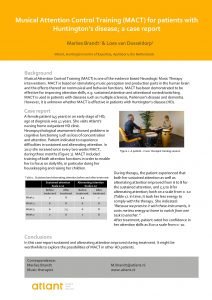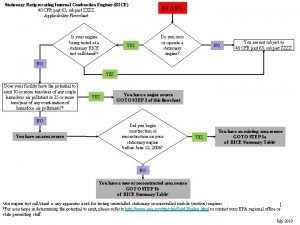Musical Attention Control Training MACT for patients with

- Slides: 1

Musical Attention Control Training (MACT) for patients with Huntington’s disease; a case report Marlies 1 Atlant, 1 Brandt & Loes van 1 Dusseldorp Huntington Centre of Expertise, Apeldoorn, the Netherlands Background Musical Attention Control Training (MACT) is one of the evidence based Neurologic Music Therapy interventions. MACT is based on stimulating music perception and production parts in the human brain and the effects thereof on nonmusical and behavior functions. MACT has been demonstrated to be effective for improving attention skills, e. g. sustained attention and attentional control/switching. MACT is used in patients with diseases such as multiple sclerosis, Parkinson’s disease and dementia. However, it is unknown whether MACT is effective in patients with Huntington’s disease (HD). Case report A female patient (45 years) in an early stage of HD; age at diagnosis was 41 years. She visits Atlant’s nursing home outpatient HD clinic. Neuropsychological assessment showed problems in cognitive functioning such as loss of concentration and attention. Patient indicated to experience difficulties in sustained and alternating attention. In 2017 she received once every two weeks MACT, during three months (Figure 1). MACT included training of both attention functions in order to enable her to focus on daily life, in particular doing her housekeeping and raising her children. Table 1. Sustained and alternating attention before and after treatment Week 1 Sustained attention Scale 0 -10 Before After treatment 7 8 Alternating attention Scale 0 -10 Before After treatment 5. 5 7 Week 3 6 8 Week 5 6 7. 5 6 8 Week 7 7 8 Figure 1. A patient - music therapist training session During therapy, the patient experienced that both her sustained attention as well as alternating attention improved from 6 to 8 for the sustained attention, and 5. 5 to 8 for alternating attention; both on a scale from 0 -10 (Table 1). In time, it took her less energy to comply with therapy. She indicated: “Because we practice it with these instruments, it costs me less energy at home to switch from one task to another. ” After treatment, patient rated her confidence in her attention skills as 8 on a scale from 0 -10. Conclusions In this case report sustained and alternating attention improved during treatment. It might be worthwhile to explore the possibilities of MACT in other HD patients. Correspondence: Marlies Brandt Music therapist M. Brandt@atlant. nl www. atlant. nl

